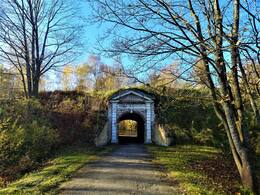Estijos karinis jūrų laivynas padėjo Latvijos pajėgoms Nepriklausomybės karo metu.
Birželio 23 d. estai švenčia Pergalės dieną, taip pažymėdami bendrą Latvijos ir Estijos pergalę Cėsių mūšyje. Ir šioje pergalėje reikšmingą vaidmenį atliko Estijos karinis jūrų laivynas, kuris šiame Landesvero kare, kaip jį vadina estai, savo drąsiais veiksmais ir taikliais patrankų ugnimi prie Dauguvos žiočių kėlė grėsmę pagrindiniams vokiečių pajėgų tiekimo keliams per Dauguvą, esantiems visai netoli Rygos.
Geležinės divizijos ir Baltijos vokiečių landesvero žygis Cėsių link, su galimu tolesniu judėjimu šiaurės rytų kryptimi, estai vertino kaip realią grėsmę Estijai. Todėl Estijos armijos vyriausiasis vadas Johanas Laidoneris pasiuntė dideles pajėgas Cėsių link, sustiprindamas jas šarvuotais traukiniais. Taip pat reikėtų atsižvelgti į tai, kad Taline buvo įsikūrusi britų karinio jūrų laivyno bazė, o vienas iš vokiečių tikslų buvo susilpninti britų laivyno buvimą Baltijos jūroje arba net pasiekti visišką jo pasitraukimą iš anksčiau vokiečių kontroliuotų teritorijų.
Estijos ginkluotųjų pajėgų vyriausiasis vadas Johanas Laidoneris ir karinių jūrų pajėgų vadas Johanas Pitka nusprendė nedelsdami pulti vokiečių pajėgas netoli Rygos iš jūros, taip paremdami ir padėdami Estijos ir Latvijos sausumos pajėgoms. Kai estai apie šį planą informavo Taline buvusį britų sąjungininkų atstovą, jie gavo atsakymą, kad tai gali būti didelė klaida, kurią vėliau bus sunku ištaisyti. Užkulisiuose veržiantis politinėms intrigoms, britai tuo metu, matyt, tikėjosi toliau nukreipti fon der Golco karines pajėgas ir panaudoti jas savo interesais, kad sunaikintų bolševikų pajėgas Rusijoje. Tačiau sudėtingoje politinėje situacijoje estai vis dėlto nusprendė įgyvendinti šį planą ir parengė karinę operaciją Daugavgryvai pulti.
1919 m. birželio 26 d. išplaukė Estijos eskadrilė. Ją sudarė eskadrilinis minininkas „Lennuk“, patrankinis kateris „Lembit“, minų traleriai „Olev“ ir „Kalev“, patrankomis ginkluotas ledlaužis „Tasuja“, prie kurio buvo pritaisyta barža su amunicija ir kuru. Buvo planuota, kad prie šių karinių jūrų pajėgų prisijungs ir eskadrilinis minininkas „Vambola“. Birželio 28 d. eskadrilė pasiekė Pernu upę ir ten nuleido inkarą, „Vambola“ priartėjo prie baržos ir papildė degalų atsargas. Toliau laikydamasi arti kranto, kad užmaskuotų savo judėjimą, Estijos eskadrilė priartėjo prie Gaujos upės žiočių ir ten nuleido inkarą, kad pasiruoštų puolimui.
Liepos 2 d. ankstų rytą, kai sausumos pajėgos jau puolė Rygos priemiesčius, patrankų laivui „Lembit“ buvo įsakyta įplaukti į Dauguvos upės žiotis ir nutildyti vokiečių kranto baterijas, nes tuo metu buvo žinoma, kad estų sausumos daliniai jau buvo pasiekę Mylgravi. „Lembit“ buvo pasirinktas dėl mažos grimzlės ir gero manevringumo. Kai „Lembit“ taiklia ugnimi sunaikino vokiečių kranto baterijas, į mūšį stojo estų naikintojas „Vambola“, artėdamas prie Daugavgryvos tvirtovės ir nutildydamas savo vokiečių pabūklus. Tuo metu du vokiečių lėktuvai bandė atakuoti estų laivus, tačiau abu buvo numušti priešlėktuviniais ginklais. Vokiečiai pabėgo ir paliko Daugavgryvos tvirtovę, o vokiečių suformuota upės flotilė, ginkluota ir skirta mūšiams Dauguvoje, pateko į estų rankas. Tai maži upių laivai, ginkluoti kulkosvaidžiais ir net mažomis patrankomis. Perkėlę dalį savo įgulų į šiuos laivus, estų jūreiviai išplaukė Dauguva aukštyn į Bolderają ir, atidengdami ugnį, užėmė ten esančią vokiečių kranto bateriją. Vokiečiai priešinasi ir yra sunaikinami, tačiau dalis sugautų ir sužeistų yra išgabenami į didelius laivus Dauguvos žiotyse. Vokiečių pajėgoms šie netikėti išpuoliai iš jūros gerokai sumažino jų kovinius pajėgumus ir kėlė grėsmę jų armijos aprūpinimui per Dauguvą, jie demoralizavo jų kovinę dvasią ir atėmė norą tęsti kovą.
Vėliau Estijos karinio jūrų laivyno vadas Johanas Pitka pripažino, kad ši jūrų kovinė operacija buvo viena sėkmingiausių ir reikšmingiausių per visą Estijos landesvero karą. Stebuklingai, pripažįsta patys estai, ši reikšminga kovinė operacija Dauguvos upės žiotyse estams įvyko be nuostolių.
Įdomu ir tai, kad estai išsilaipino ir Mangalsaloje, kurios gyventojai stebėjo mūšius kitame Dauguvos krante maždaug iš 2 kilometrų atstumo. Prieš karą estų žvejai iš savo pakrantės Pernu iki Narvos lašišų žvejybos sezono metu, kuris trukdavo nuo Joninių iki Mykolų, dažnai keliaudavo į šią Latvijos pakrantę pelno siekdami. Ir paaiškėjo, kad tarp estų kareivių buvo tokių lašišų žvejų, ir jie Mangalsaloje sutiko pažįstamų Latvijos žvejų, su kuriais žvejojo dar prieš pasaulinį karą. Jie vėl susitiko kaip geri ir seni draugai. Ir kaip jie galėjo nesusitikti – kai karas jau baigėsi.
Žurnalas „Jūreivis“
Susijusios temos
Susijusios vietos
Daugavgryvos tvirtovė
Daugavgryvos tvirtovė (įėjimas iš Birzės gatvės) yra Daugavgryvos saloje, kur Bulupės upė įteka į Dauguvos upę. Tvirtovė buvo pastatyta XVII a., siekiant apsiginti nuo priešų, judančių Rygos kryptimi, kuri buvo svarbus administracinis, prekybos ir gamybos centras. Vėliau ji tapo pagrindiniu Latvijos armijos pakrantės gynybos įtvirtinimu su keliais atramos taškais. Ši gynybinė įtvirtinimų sistema yra vienas vertingiausių Latvijos karinio paveldo objektų. Ši tvirtovė yra Latvijos karinės istorijos liudininkė. Pavyzdžiui, Krymo karo metu (1853–1856 m.) čia buvo mokomos Latvijos ir Estijos patrankinių valčių įgulos. Pagrindinis šių dalinių tikslas buvo ginti vietos uostus ir pakrantę nuo britų karinio jūrų laivyno atakų. Pirmojo pasaulinio karo metu čia buvo suformuotos Daugavgryvos milicijos kuopos. Tai buvo pirmieji Latvijos koviniai daliniai, atsiradę dar anksčiau nei Latvijos šauliai. Šiandien galima pamatyti tvirtovės teritoriją. Netoliese yra Kometfortas ir Pajūrio gamtos parkas, o kitoje Dauguvos pusėje – Mangaļsalos įtvirtinimai.





